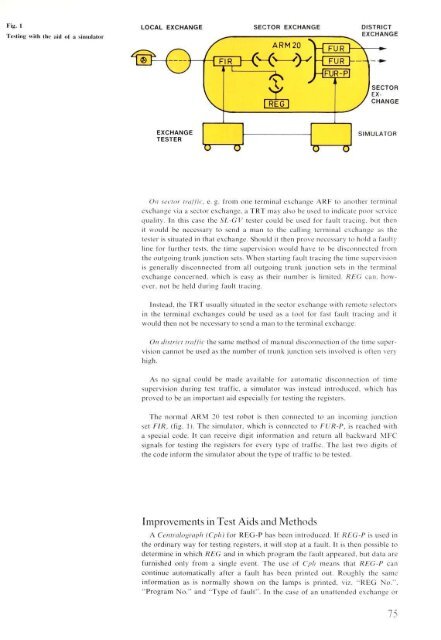Ericsson Technics - ericssonhistory.com
Ericsson Technics - ericssonhistory.com
Ericsson Technics - ericssonhistory.com
Create successful ePaper yourself
Turn your PDF publications into a flip-book with our unique Google optimized e-Paper software.
Fig. 1Testing with the aid of a simulatorO/; sector traffic, e. g. from one terminal exchange ARF to another terminalexchange via a sector exchange, a TRT may also be used to indicate poor servicequality. In this case the SL-GV tester could be used for fault tracing, but thenit would be necessary to send a man to the calling terminal exchange as thetester is situated in that exchange. Should it then prove necessary to hold a faultyline for further tests, the time supervision would have to be disconnected fromthe outgoing trunk junction sets. When starting fault tracing the time supervisionis generally disconnected from all outgoing trunk junction sets in the terminalexchange concerned, which is easy as their number is limited. REG can, however,not be held during fault tracing.Instead, the TRT usually situated in the sector exchange with remote selectorsin the terminal exchanges could be used as a tool for fast fault tracing and itwould then not be necessary to send a man to the terminal exchange.On district traffic the same method of manual disconnection of the time supervisioncannot be used as the number of trunk junction sets involved is often veryhigh.As no signal could be made available for automatic disconnection of timesupervision during test traffic, a simulator was instead introduced, which hasproved to be an important aid especially for testing the registers.The normal ARM 20 test robot is then connected to an in<strong>com</strong>ing junctionset FIR, (fig. 1). The simulator, which is connected to FUR-P, is reached witha special code. It can receive digit information and return all backward MFCsignals for testing the registers for every type of traffic. The last two digits ofthe code inform the simulator about the type of traffic to be tested.Improvements in Test Aids and MethodsA Centralograph (Cph) for REG-P has been introduced. If REG-P is used inthe ordinary way for testing registers, it will stop at a fault. It is then possible todetermine in which REG and in which program the fault appeared, but data arefurnished only from a single event. The use of Cph means that REG-P cancontinue automatically after a fault has been printed out. Roughly the sameinformation as is normally shown on the lamps is printed, viz. "REG No."."Program No." and "Type of fault". In the case of an unattended exchange or75















